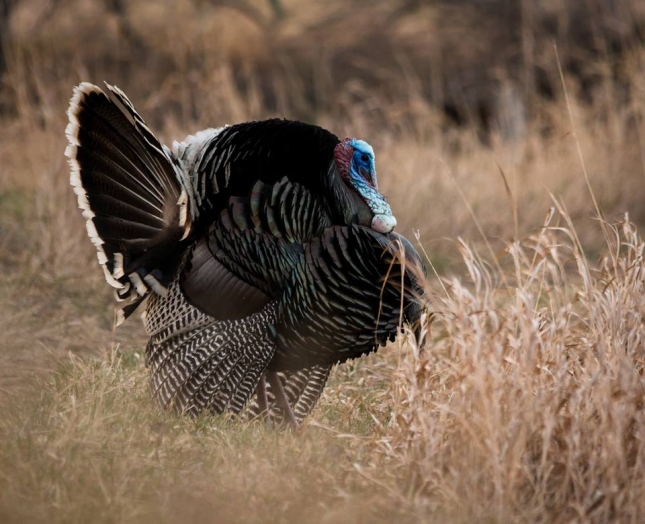FUN FACTS ABOUT WILD TURKEYS
Wild Turkeys are not just seen around Thanksgiving time, but are common the rest of the year too. Once they became popular at the dinner table, their populations dropped drastically. However, after being reintroduced, their numbers have recovered.
APPEARANCE:
- Wild Turkeys look a bit like prehistoric dinosaurs
- They are extremely large birds, with long legs, and a rounded tail
- The neck of the Wild Turkey is long with a small head
- Their overall coloring is an iridescent, dark green
- The wings of the Wild Turkey are dark in color with a strong barred pattern with white
- Rump and tail feathers of Wild Turkeys living in the Rockies tend to be whitish
- They have bare skin on their heads and neck that varies from red, to blue, to gray
SONG:
- A male Turkey’s call is a loud, shrill, descending, throaty jumble of sounds
- The male Turkey’s call lasts about one second
- Males will use their call to attract females and as a response to other males
- When males and females fly down from their roosts in the trees they will cackle, using a short purring sound
- While traveling on foot they will give a series of yelps to help reassemble the flock
- When lost, young Turkeys will whistle several times to their flock mates
HABITAT:
- Wild Turkey like wooded areas (mature forests) bordered by fields
- They particularly like trees that bear nuts, such as oak, hickory or beech
- Wild Turkeys may be spied next to the road, or in woodsy backyards
- The Wild Turkey inhabits every state except Alaska
BEHAVIOR:
- Turkeys mostly get around by walking, but can fly and also swim, if needed
- At dusk Wild Turkey will find trees to roost in and will roost in the lower branches
- When threatened, females will fly, while males will mostly run
- Young chicks travel in family groups with their mother and will band together in larger groups to form large flock of young turkeys accompanied by two or more adult females
- There is an independent pecking order for each sex
- Females have a stable pecking order
- Male hierarchy changes
FOOD:
- They swallow grit, to help them digest their food
- The Spring, Summer and Fall diet of the Wild Turkey is comprised mainly of plant matter that they have foraged for on the ground, such as acorns, American beech nuts, pecans, hickory nuts, wild black cherries, white ash seeds and other seeds and berries
- Wild Turkeys may even eat plant bulbs in the Spring, when other food sources are scarce
- During the summertime they may supplement their diet of sedges, grasses and stripped seeds, along with salamanders, snails, ground beetles and other insects
- During the winter, when there is deep snow on the ground, they will eat hemlock buds, evergreen ferns, spore covered fronds of sensitive ferns, club mosses, and burdock
NESTING:
- When courting, males will puff themselves up and exhibit exuberant gobbling
- Males will have multiple mates
- Only the females provide parental care to the young. The males provide no care
- The females nest on the ground, scratching an indentation about one inch deep, 8-11 inches wide and 9-13 inches long
- Nests may be located at the base of trees, underbrush piles or thick shrubbery, and even in open hay fields
- They will use leaves and other plant materials that are already at the nest site for their nest
- Clutch Size: 4-17 eggs
- Number of Broods: 1
- Egg size: 1.9-2.7”L x 1.6-1.9”W
- Incubation Period: 25-31 days
- Nestling Period: 1 day
- Egg Coloration: Yellowish-tan with evenly marked brown or pinkish spots
- Condition of Chick at Hatching: Well-developed, covered with down that is tawny, brown, pinkish, and gray
ATTRACTING WILD TURKEYS TO YOUR PROPERTY:
- If your property is near the woods, you can attract Wild Turkeys by planting nut and berry bearing trees
- Turkeys can also be attracted by scattering birdseed or corn seed in the yard; however, doing this may also attract unwanted rodents
OTHER FUN WILD TURKEY FACTS:
- Wild Turkeys are one of two domesticated bird species from the New World
- They were originally brought to Europe from Mexico by explorers in the early 16th century
- The Wild Turkey had been domesticated by the inhabitants of Mexico for several centuries
- They may have gotten their name from an early trading route that ran through the country of Turkey
- When numbers dwindled, Wild Turkeys were transported and introduced to other areas and now live in the lower 48 states, Hawaii and parts of Canada


